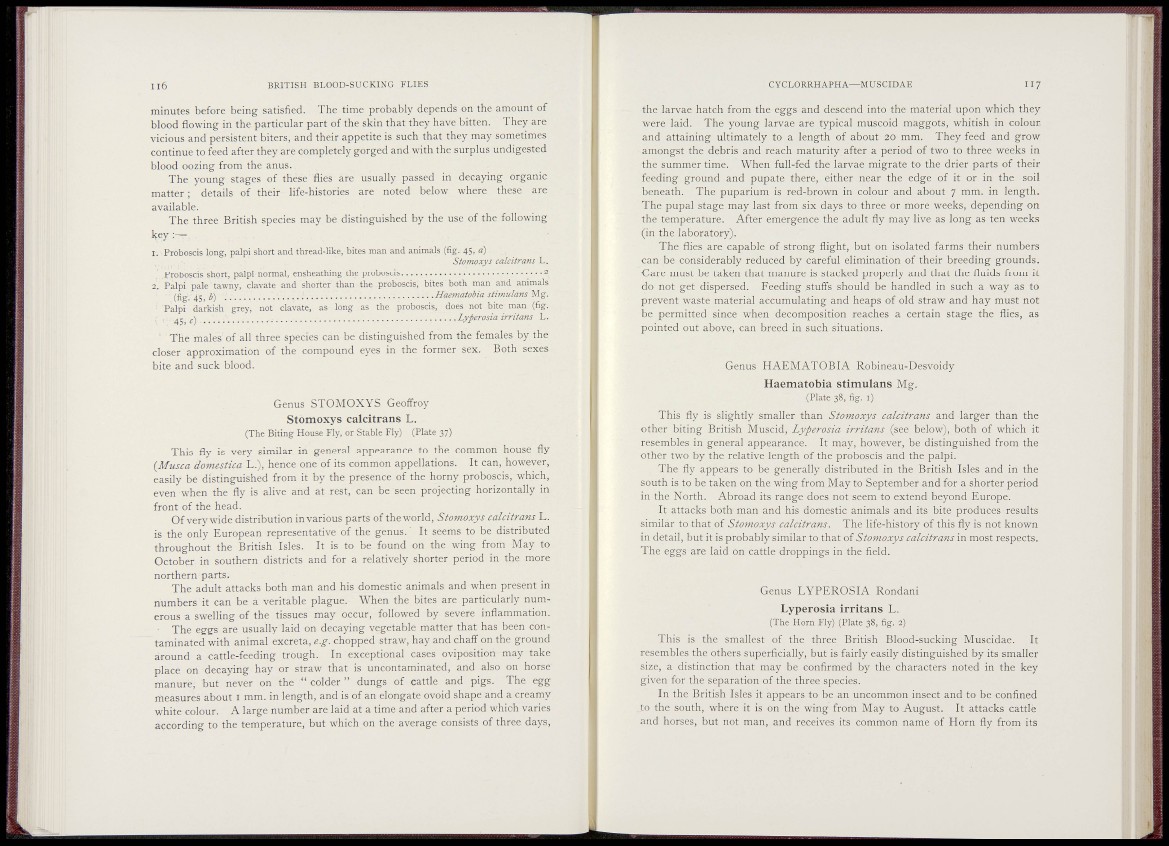
mL.
i i 6 BRITISH BLOOD-SUCKING FLIES CYCLORRHAPHA—MUSCIDAE 117
minutes before being satisfied. The time probably depends on the amount of
blood flowing in the particular part of the skin that they have bitten. They are
vicious and persistent biters, and their appetite is such that they may sometimes
continue to feed after they are completely gorged and with the surplus undigested
blood oozing from the anus.
The young stages of these flies are usually passed in decaying organic
matter ; details of their life-histories are noted below where these are
available.
The three British species may be distinguished by the use of the following
key
1. Proboscis long, palpi short and thread-like, bites man and animals (figS.i o4m5o, xay)s ca lei trans L.
Proboscis short, palpi normal, ensheathing the proboscis • - 2
2. Palpi pale tawny, clavate and shorter than the proboscis, bites both man and animals
(fig. 45, ¿) Haematobia stimulans Mg.
Palpi darkish grey, not clavate, as long as the proboscis, does not bite man (fig.
Lyperosia irritans L.
The males of all three species can be distinguished from the females by the
closer approximation of the compound eyes in the former sex. Both sexes
bite and suck blood.
Genus STOR-IOXYS Geoffroy
Stomoxys calcitrans L.
(The Biting House Fly, or Stable Fly) (Plate 37)
This fly is very similar in general appearance to the common house fly
{Musca domestica L.), hence one of its common appellations. It can, however,
easily be distinguished from it by the presence of the horny proboscis, which,
even when the fly is alive and at rest, can be seen projecting horizontally in
front of the head.
Of very wide distribution in various parts of the world, Stomoxys calcitrans L.
is the only European representative of the genus. It seems to be distributed
throughout the British Isles. It is to be found on the wing from May to
October in southern districts and for a relatively shorter period in the more
northern parts.
The adult attacks both man and his domestic animals and when present in
numbers it can be a veritable plague. When the bites are particularly numerous
a swelling of the tissues may occur, followed by severe inflammation.
The eggs are usually laid on decaying vegetable matter that has been contaminated
with animal excreta, e.g. chopped straw, hay and chaff on the ground
around a cattle-feeding trough. In exceptional cases oviposition may take
place on decaying hay or straw that is uncontaminated, and also on horse
manure, but never on the " colder " dungs of cattle and pigs. The egg
measures about i mm. in length, and is of an elongate ovoid shape and a creamy
white colour. A large number are laid at a time and after a period which varies
according to the temperature, but which on the average consists of three days,
the larvae hatch from the eggs and descend into the material upon which they
were laid. The young larvae are typical muscoid maggots, whitish in colour
and attaining ultimately to a length of about 20 mm. They feed and grow
amongst the debris and reach maturity after a period of two to three weeks in
the summer time. When full-fed the larvae migrate to the drier parts of their
feeding ground and pupate there, either near the edge of it or in the soil
beneath. The puparium is red-brown in colour and about 7 mm. in length.
The pupal stage may last from six days to three or more weeks, depending on
the temperature. After emergence the adult fly may live as long as ten weeks
(in the laboratory).
The flies are capable of strong flight, but on isolated farms their numbers
can be considerably reduced by careful elimination of their breeding grounds.
Care must be taken that manure is stacked properly and that the fluids from it
do not get dispersed. Feeding stuffs should be handled in such a way as to
prevent w^aste material accumulating and heaps of old straw and hay must not
be permitted since when decomposition reaches a certain stage the flies, as
pointed out above, can breed in such situations.
Genus HAEMATOBIA Robineau-Desvoidy
Haematobia stimulans Mg.
(Plate 38, fig, i)
This fly is slightly smaller than Stomoxys calcitrans and larger than the
other biting British Muscid, Lyperosia ir7-itans (see below), both of which it
resembles in general appearance. It may, however, be distinguished from the
other two by the relative length of the proboscis and the palpi.
The fly appears to be generally distributed in the British Isles and in the
south is to be taken on the wing from May to September and for a shorter period
in the North. Abroad its range does not seem to extend beyond Europe.
It attacks both man and his domestic animals and its bite produces results
similar to that of Stomoxys calcitrans. The life-history of this fly is not known
in detail, but it is probably similar to that of Stomoxys calcitrafis in most respects.
The eggs are laid on cattle droppings in the field.
Genus LYPEROSIA Rondani
Lyperosia irritans L.
(The Horn Fly) (Plate 38, fig. 2)
This is the smallest of the three British Blood-sucking Muscidae. It
resembles the others superficially, but is fairly easily distinguished by its smaller
size, a distinction that may be confirmed by the characters noted in the key
given for the separation of the three species.
In the British Isles it appears to be an uncommon insect and to be confined
to the south, where it is on the wing from May to August. It attacks cattle
and horses, but not man, and receives its common name of Horn fly from its